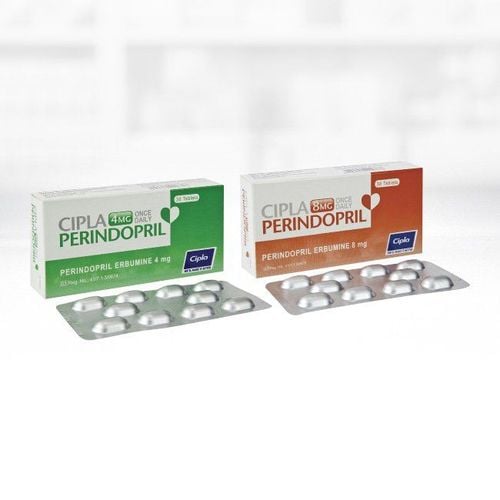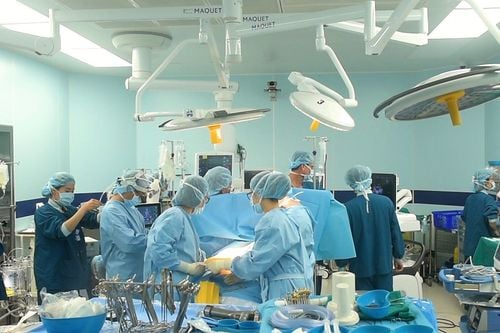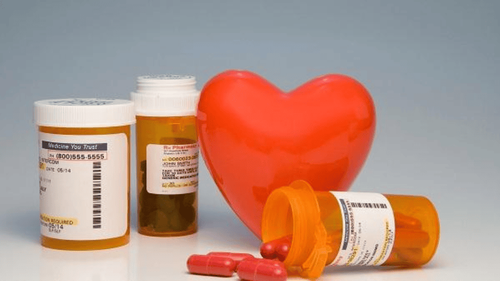This is an automatically translated article.
Bisocar 2.5 mg and 5 mg are indicated for the treatment of angina pectoris, high blood pressure, chronic heart failure,... Here is the reference information about the drug Bisocar. However, the use of the drug must still be according to the instructions of the doctor who prescribes the drug.
1. What is Bisocar?
Bisocar 2.5 mg and 5 mg contains the active ingredient Bisoprolol fumarate, is made in the form of film-coated tablets, heart-shaped, slightly convex sides and packed in the following specifications: Box of 10 blisters x 10 tablets.
Uses of Bisocar 5 mg and 2.5 mg are used to treat angina pectoris, hypertension and stable chronic heart failure with reduced left ventricular systolic function in combination with ACE inhibitors, diuretics urine and cardiac glycosides.
Pharmacodynamics:
Bisocar is a highly selective beta-1-adrenergic receptor blocker with no intrinsic sympathomimetic effects and no membrane stabilizing properties. Bisocar has been shown to have a low affinity for beta-2 receptors of bronchial and vascular smooth muscle as well as an effect on beta-2 receptors involved in metabolic regulation. Therefore, Bisocar generally has no effect on airway impedance and beta-2 receptor-mediated metabolic effects. Its beta-1-selectivity persists at doses beyond the therapeutic dose range. Bisocar is used to treat hypertension, angina, and heart failure. The efficacy of Bisocar is comparable to that of other beta-blockers, and the mechanism of action on hypertension is not well understood. However, Bisocar markedly reduced plasma rennin effects. Mechanism of treatment of angina: By blocking beta receptors on the heart, bisocar inhibits sympathetic nervous activity. The result is a decrease in heart rate and myocardial contractility leading to a decrease in myocardial oxygen demand. In the acute treatment of coronary heart disease patients without chronic heart failure, Bisocar reduces heart rate and volume of blood ejected during each heart beat, thereby reducing cardiac output and oxygen consumption. In chronic treatment, Bisocar reduces the initially elevated peripheral arterial resistance. Pharmacokinetics:
Absorption: Bisocar is almost completely absorbed from the gastrointestinal tract and metabolized in the liver for the first time is very little, so bioavailability is quite high, about 90%. The drug has linear pharmacokinetics over a wide dose range from 2.5 to 100 mg, independent of age. Food does not affect drug absorption. Distribution: Approximately 30% of bisoprolol is bound to plasma proteins. The volume of distribution is 3.5 l/kg.
2. Dosage of the drug Bisocar
How to use Bisocar:
Take orally. The drug should be taken in the morning and can be taken with food. Swallow the tablet whole with water, do not chew. Depending on the purpose of treatment, the dosage of Bisocar will be different as follows:
In the treatment of hypertension: Usual dose: 2.5 - 5 mg x 1 time / day. For patients whose blood pressure is not controlled by the starting dose, the dose may be increased depending on tolerance to 10 mg, in severe cases may be increased to a maximum of 20 mg/day. In the treatment of increased angina: Usual dose: Take a single dose of 5-10 mg/day. Maximum dose: 20 mg/day. No dose adjustment is necessary in patients with mild to moderate renal and hepatic dysfunction. The starting dose may be 2.5 mg/day and the dose should be adjusted accordingly. The dose of Bisoprolol fumarate should not exceed 10 mg/day. In the treatment of heart failure: Initial dose: 1.25 mg/day as a single dose. If tolerated, the dose can be doubled after 1 week, and the dose is increased gradually over 1-4 weeks to the maximum dose tolerated by the patient but should not exceed 10 mg/day. No dose adjustment is necessary in elderly patients except in cases of significant renal and hepatic dysfunction. Elderly With normal renal and hepatic function: No dose change is required. Renal or hepatic impairment In patients with severe renal impairment (creatinine clearance between 5 - 20 ml/min) and in patients with severe or progressive liver injury, no more than 10 mg/day is recommended.
3. What to do in case of overdose or missed dose?
If the patient overdoses, Bisoprolol must be discontinued and supportive, symptomatic treatment. Based on the known effects and recommendations for other beta-blockers, the following clinical signs should be discontinued and appropriate treatment instituted:
Bradycardia : Intravenous Atropine. If the response is inadequate, isoprenaline or some other drug known to increase heart rate may be used cautiously. In some cases, put a pacemaker if necessary. Hypotension: Intravenous fluids and antihypertensive drugs. Glucagon can be administered intravenously. Atrioventricular block (2nd or 3rd degree): Carefully monitor the patient and administer Isoprenali or pacemaker. Severe acute heart failure: Intravenous Aminophylline and treatment of heart failure with cardiovascular drugs (digitalis) and diuretics, inotropic agents, vasodilators. Bronchospasm: Use bronchodilators such as Isoprenalin, beta-2 sympathomimetic and/or Aminophyllin. Hypoglycemia: Intravenous glucose injection. If the patient forgets to take a dose, take it as soon as possible. However, if it is almost time for your next dose, skip the missed dose and take your next dose at the scheduled time. Do not take twice the prescribed dose.
4. Side effects of Bisocar 2.5 mg and 5 mg
When using Bisocar, patients may experience undesirable effects such as:
Common side effects: Fatigue, dizziness, dizziness, headache, sweating, sleep disturbance, anxiety, distraction and depression. These symptoms are usually less severe and usually go away within 1 to 2 weeks after starting treatment. Occasional side effects: Gastrointestinal disturbances; hypotension, bradycardia or atrioventricular conduction disturbances, numbness and cold sensation in the extremities. Rare side effects: Skin reactions, myasthenia gravis, cramps and decreased lacrimation (if contact lenses are worn), increased airway resistance (dyspnea in patients predisposed to spasmodic reactions). bronchi). In patients with lameness and Raynaud's phenomenon, at the beginning of treatment, these symptoms may become more severe and myocardial failure may be more severe. In elderly patients with diabetes, signs of hypoglycemia such as tachycardia may be masked. Laboratory abnormalities:
Often there is an increase in serum triglycerides but unlikely to be caused by the drug; There was a slight increase in uric acid, creatinine, BUN, serum potassium, glucose and phosphorus, white blood cells, platelets. These changes are not clinically important and rarely require discontinuation of Bisoprolol fumarate. Instructions on how to handle side effects:
When experiencing side effects of the drug, it is necessary to stop using and notify the doctor or go to the nearest medical facility for timely treatment.
5. Notes when using Bisocar
Bisocar 2.5 is contraindicated in the following cases:
Acute heart failure or in periods of decompensated heart failure requiring intravenous infusion of inotropic drugs; 2nd or 3rd degree atrioventricular block; Sinus node insufficiency syndrome; Sinus atrial block; Bradycardia causing physical symptoms (less than 60 beats/min); Low blood pressure causing physical symptoms; Severe bronchial asthma or severe chronic obstructive pulmonary disease; Some severe forms of peripheral artery occlusion or some severe forms of Raynaud's syndrome; Untreated adrenal myeloma; Hypersensitivity to Bisoprolol or any of its ingredients. Use with caution:
Treatment of stable chronic heart failure with Bisoprolol must be initiated with a special dose adjustment period. Initiating and stopping treatment of stable chronic heart failure with Bisoprolol requires regular monitoring. There is no experience with bisoprolol treatment in patients with heart failure and concomitant insulin-dependent diabetes mellitus (type 1), severe renal and hepatic impairment, restrictive cardiomyopathy, congenital heart disease, valvular heart disease. hemodynamically related entities, myocardial infarction within 3 months. Patients with coronary heart disease who abruptly discontinue therapy are at increased risk of myocardial infarction and sudden death. Especially for patients with ischemic heart disease, do not stop taking bisocar suddenly unless clearly directed by your doctor, as this may worsen the heart condition during transition. . Patients must be cautious when using Bisocar in the treatment of hypertension or angina associated with heart failure. bronchial asthma, road-resistant chronic obstructive pulmonary disease Ability to drive and use machines:
The effect of the drug on the ability to drive and use machines has not been studied. In a study of patients with coronary heart disease, Bisocar did not affect the ability to drive. However, depending on the individual response, the ability to drive and use machines may be impaired. Particular attention should be paid to this possibility when starting treatment, when changing doses or when taking the drug with alcohol. Pregnancy:
The pharmacodynamic effects of Bisocar may cause harm to a pregnant woman and/or the fetus/newborn child. In general, beta-blockers reduce blood flow to the placenta leading to growth retardation, stillbirth, or preterm delivery. Side effects (such as hypoglycemia, bradycardia) may occur in the fetus and neonate. If treatment with beta-blockers is necessary, selective beta-1 receptor blockers should be used. Bisocar is not recommended for pregnant women unless clearly needed. If treatment with Bisocar is necessary, close monitoring of blood flow to the uterus, placenta and fetal growth should be followed. In the event of adverse effects on a pregnant woman or her unborn child, a change in treatment should be considered. Newborns need to be closely monitored. Lactation:
There are no data on the distribution of Bisocar into breast milk or its safety in the neonate. Therefore, the use of Bisocar in nursing women is not recommended. Drug interactions:
Should not be combined with other beta-blockers. Concomitant treatment of Bisocar with catecholamine-depleting drugs (reserpine, alpha-methyldopa, clonidine and guanethidine) may result in a significant reduction in heart rate. In patients treated concomitantly with Clonidine, if discontinuation of the drug is desired, it is recommended that Bisocar be discontinued for several days prior to discontinuation of Clonidine. Concomitant use of Bisocar with drugs that relax the myocardium or inhibit atrioventricular conduction such as certain calcium antagonists (especially Phenylalkylamine [Verapamil] and Benzothiazepine [Diltiazem]) classes) or antiarrhythmic agents (Disopyramide) hypotension, bradycardia, arrhythmia or heart failure may occur. When used concurrently with Reserpine, Alpha-methyldopa, Guanfacine, Clonidine or Glycosides can significantly reduce heart rate. Rifampin increases the metabolism and elimination of Bisoprolol fumarate thereby shortening the half-life of the drug. However, no dose adjustment of Bisocar is necessary. Using Bisocar at the same time as insulin and oral hypoglycemic agents, increasing their potential for action. Symptoms of hypoglycemia (especially tachycardia) are masked or mitigated. Blood sugar levels must be monitored regularly. In summary, the use of Bisocar 5 mg and 2.5 mg is used to treat angina, hypertension and stable chronic heart failure with reduced left ventricular systolic function in combination with ACE inhibitors. diuretics and cardiac glycosides. Patients need to use the drug exactly as prescribed by the doctor to increase the effectiveness of treatment and ensure safety for health.
Please dial HOTLINE for more information or register for an appointment HERE. Download MyVinmec app to make appointments faster and to manage your bookings easily.













